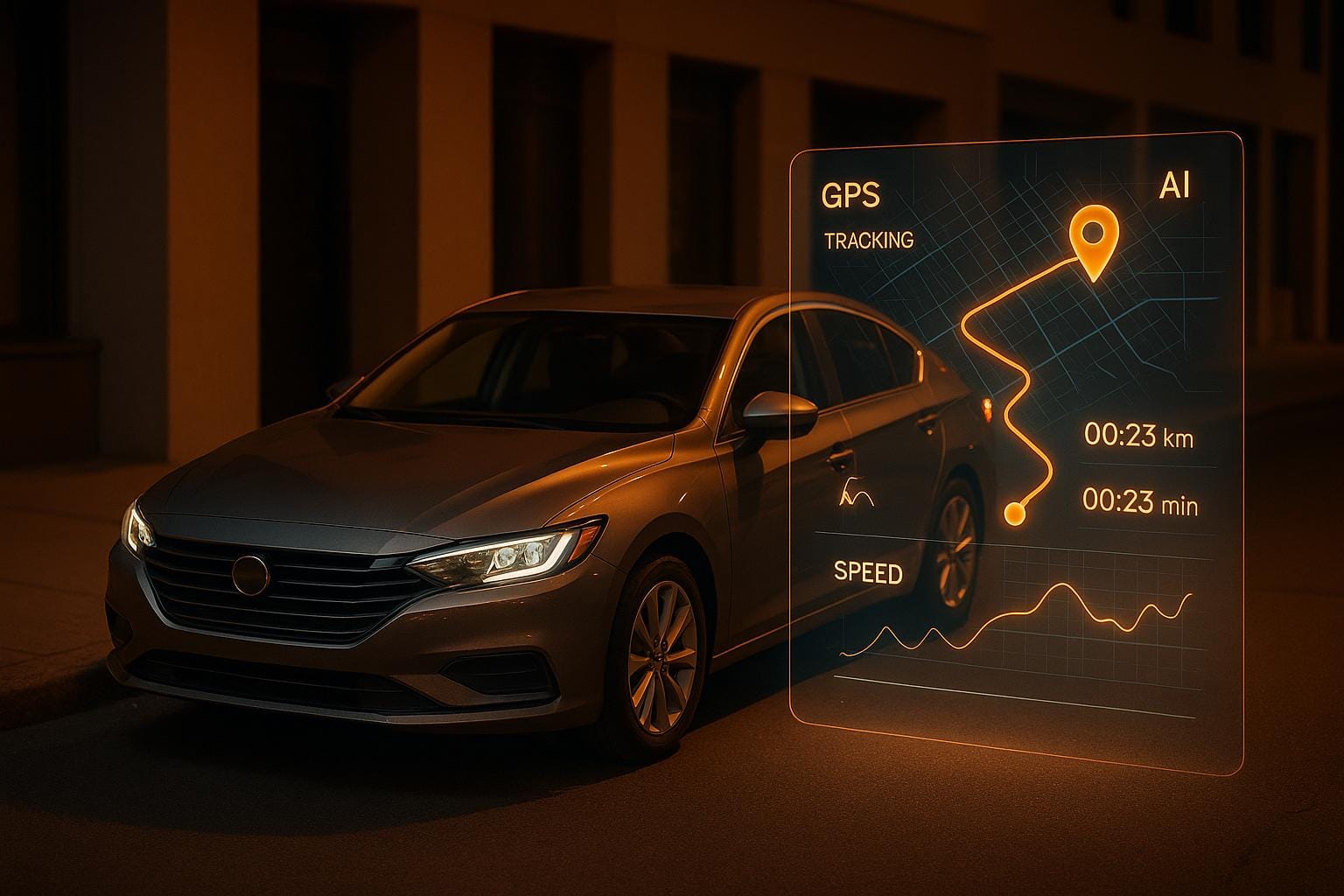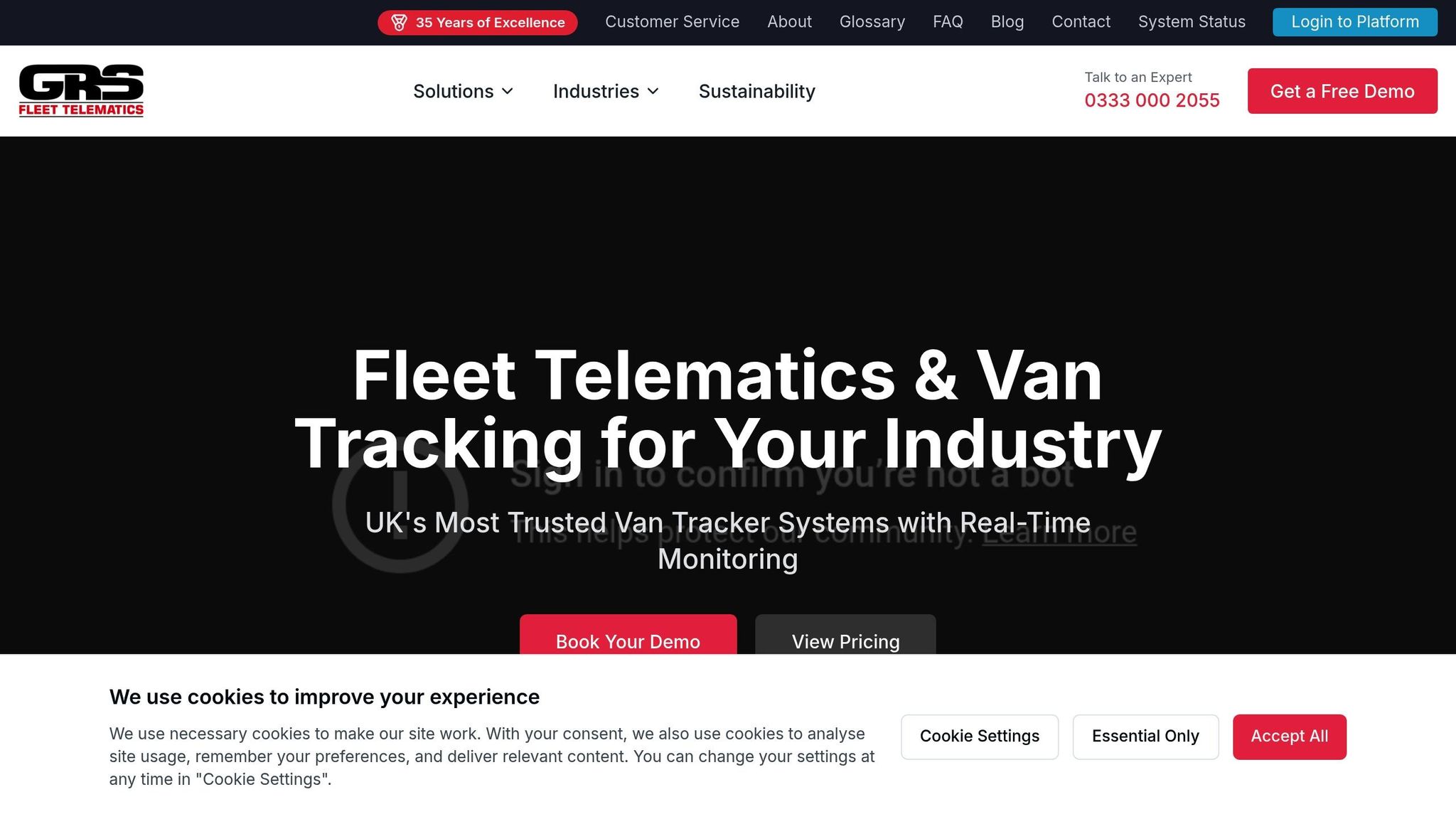AI GPS Tracking for Theft Prevention
Explore how AI GPS tracking enhances vehicle theft prevention with real-time monitoring, predictive analytics, and remote immobilisation features.

AI GPS tracking systems are transforming vehicle theft prevention by combining GPS accuracy with artificial intelligence. These systems monitor real-time locations, detect unusual activities, and even immobilise vehicles remotely. With features like geofencing, predictive analytics, and mobile app control, they offer a proactive approach to securing vehicles.
Key Facts:
- Vehicle Theft in the UK: A car is stolen every 5 minutes, with over 130,000 thefts reported in 2022.
- Recovery Rates: Vehicles with AI GPS tracking have up to a 91% recovery rate, compared to just 2–8% with older methods.
- Insurance Benefits: Discounts of up to 32% for vehicles equipped with these systems.
- Costs: Basic systems start at £40, with monthly fees from £8 to £24.
AI-powered trackers are especially effective for businesses managing fleets, offering real-time updates, geofencing alerts, and risk monitoring. However, they require strong network connectivity and come with privacy and cost considerations. GRS Fleet Telematics provides tailored solutions for UK businesses, starting at £7.99 per month, with recovery rates as high as 91%.
CTV Ottawa "Here's how to beef up the security on your vehicle"
Key Features of AI GPS Tracking Devices
AI GPS tracking devices are designed to safeguard vehicles by offering advanced location monitoring, theft detection, and quick recovery solutions.
Real-Time Location Tracking
Keeping tabs on a vehicle's location in real time is at the heart of theft prevention. These devices provide constant updates, allowing you to monitor your fleet around the clock. With real-time tracking, unauthorised activity can be spotted instantly.
"The GPS trackers offer real-time tracking of the location you are driving, allowing you to watch its whereabouts round-the-clock." - GVE London
This feature also simplifies recovery efforts by enabling seamless coordination with law enforcement. For instance, Thatcham-approved GPS trackers boast an impressive 96% success rate in theft prevention and recovery.
Adding to this continuous tracking, geofencing enhances security by setting virtual boundaries.
Geofencing and Automatic Alerts
Geofencing lets you create virtual zones around specific areas, such as your business premises or customer locations. If a vehicle exits or enters these zones, the system sends immediate alerts via SMS, email, or a mobile app. This is especially useful for spotting unauthorised use outside of normal hours.
Some advanced geofencing systems can even distinguish between authorised and unauthorised movements by considering time schedules, driver profiles, or operational needs. This reduces false alarms while maintaining a high level of security.
Taking it a step further, AI pattern recognition sharpens the ability to detect potential threats.
AI Pattern Recognition and Theft Prediction
AI algorithms analyse each vehicle's usual behaviour, such as regular routes, operating hours, and driving patterns. If something out of the ordinary happens - like unexpected route changes, unusual inactivity, or deviations from established patterns - the system flags it as a possible security issue. This predictive feature allows for action to be taken before a theft can occur.
By identifying these anomalies early, the system gives you the chance to intervene before any significant damage is done.
Mobile App Control and Notifications
Modern mobile apps make it easy to stay connected to your vehicles. They provide instant access to real-time location updates, route history, and vehicle status. Some apps even allow you to share location data directly with law enforcement during a theft, speeding up the recovery process. Additionally, vehicles equipped with these systems may qualify for insurance discounts of up to 25%.
How to Set Up AI GPS Tracking for Theft Prevention
Setting up an AI-powered GPS tracking system for your fleet requires careful planning and proper execution. The process includes assessing your specific needs, correctly installing the tracking devices, and configuring the system to maximise its theft prevention capabilities.
Evaluate Your Fleet Tracking Needs
Start by identifying what data you need to collect. This could include information on vehicle activity, driver performance, fuel usage, or precise locations. Also, consider the administrative features you require, such as dashboards, alerts, mobile access, and customer support.
For high-value vehicles, opt for hard-wired trackers, which are more secure. Plug-in or battery-operated devices may be better suited for other vehicles, depending on your fleet's needs.
When selecting a telematics system, focus on how well it meets your specific requirements rather than just the cost. A slightly pricier system that covers all your needs is often more effective than a cheaper one that leaves gaps in security. Once you've determined your needs, you can move on to installation and setup.
Device Installation and Setup Tips
Proper installation is key to ensuring your system works as intended. Professional installation is recommended for optimal performance and security. Hard-wired devices should be placed in discreet, secure areas where they are not easily accessible.
For plug-in devices, avoid using obvious OBD ports, as they might be easily spotted. Battery-operated trackers provide the most flexibility and can be placed in weatherproof locations with strong GPS signal reception. However, avoid placing them in metal enclosures, as this can interfere with satellite communication.
After installing the devices, test each one immediately. Check for signal strength, location accuracy, and alert functionality using the mobile app to ensure everything works smoothly.
Set Up Geofences and Alert Systems
Create geofences around key areas like your business premises, customer locations, and approved parking zones. Set time-based rules to differentiate between authorised after-hours use and potential theft.
Configure a variety of alert types to minimise false alarms while maintaining security. For example:
- Use SMS alerts for immediate threats.
- Set up email notifications for less urgent issues.
- Enable push notifications through the mobile app for real-time updates.
Make sure multiple team members receive these alerts to ensure a prompt response at all times. Advanced geofencing systems can also integrate driver profiles and operational schedules, reducing false alarms when authorised personnel use vehicles outside of standard hours. The system can learn to identify normal patterns and flag unusual activity.
Test your geofences thoroughly by having authorised drivers cross boundaries at different times. Based on these tests, adjust the sensitivity settings to strike the right balance between security and operational efficiency.
Use AI Analytics for Risk Monitoring
AI analytics can help you monitor and address potential risks. Keep an eye on route deviations, unusual operating hours, or prolonged periods of inactivity, as these could signal security concerns. Use historical data to set predictive alerts and review weekly analytics to fine-tune your security measures.
Driver behaviour analytics can also highlight potential insider threats. For example, sudden changes in driving habits, unauthorised route changes, or unexpected vehicle usage might indicate issues that need investigation.
Respond to Theft Alerts and Work with Police
Before any incidents occur, establish clear protocols for responding to theft alerts. If an alert is triggered, verify it by contacting the driver directly. Once theft is confirmed, share real-time location data and relevant historical records with law enforcement to assist in recovery efforts.
If your system includes remote engine immobilisation, only activate it after coordinating with the police. Document each incident thoroughly to improve your response strategies for future events.
Benefits and Drawbacks of AI GPS Tracking
AI-powered GPS tracking systems come with a range of advantages, particularly in theft prevention. However, it’s essential to weigh the benefits against the potential drawbacks before deciding to implement such a system.
Main Benefits of AI GPS Tracking
AI tracking systems have demonstrated impressive success in vehicle recovery, with up to 91% of stolen vehicles recovered, compared to less than 50% using traditional methods. This highlights their ability to actively prevent and address theft.
One of the standout features is real-time monitoring, which provides instant updates on vehicle locations and activities. This allows for rapid responses to suspicious behaviour, potentially stopping theft before it happens. Beyond basic tracking, AI-powered predictive analytics take things a step further. These systems don’t just report where a vehicle is - they can analyse unusual movements, compare them to normal patterns, and even suggest possible next steps. This deeper level of insight helps identify risks before they escalate.
There are also financial benefits. Vehicles equipped with AI tracking systems can qualify for insurance premium reductions of up to 32%. On top of that, these systems can improve operational efficiency, helping businesses optimise their fleet management and cut costs.
While the advantages are clear, there are also challenges to consider.
Potential Drawbacks to Consider
Despite the benefits, AI GPS tracking systems aren’t without limitations. For one, they rely heavily on network connectivity, meaning they may not work effectively in areas with poor cellular coverage. Additionally, their accuracy can be compromised in environments lacking clear road markings or signs, which can affect the performance of computer vision components.
Privacy is another concern. Continuous tracking of vehicle locations can make drivers uncomfortable, knowing their movements are being monitored at all times.
Data security is a critical issue as well. The risk of hacking or unauthorised access to sensitive location data means robust security measures are a must to protect the information gathered by these systems.
"While GPS tracking systems can greatly enhance vehicle security and fleet management, it's essential to weigh these disadvantages against the benefits when considering their implementation." – Eryk Bottomley, Biotechnologist, Software Developer
Cost is another factor to keep in mind. High-quality AI tracking systems require a significant upfront investment, with ongoing monthly subscription fees that can add up quickly, especially for businesses managing large fleets.
Feature Comparison Table
Here’s a closer look at some key features, along with their benefits and limitations:
| Feature | Benefits | Limitations |
|---|---|---|
| Real-time Tracking | Immediate theft detection; up to 91% recovery rate | Requires strong cellular coverage; less effective in remote areas |
| AI Predictive Analytics | Identifies unusual patterns; provides actionable insights | Complex setup; potential for initial false alerts |
| Geofencing Alerts | Notifies when vehicles leave designated areas | Dependent on network availability; risk of false alarms |
| Remote Immobilisation | Allows vehicles to be disabled remotely | Effectiveness depends on system integration |
| Insurance Discounts | Potential for up to 32% premium reductions | Discount rates vary by insurer |
Cost Considerations
Basic GPS trackers range from £40 to £80, while mid-range systems cost between £80 and £200. Installation fees typically fall between £80 and £160, with monthly subscriptions costing £8 to £24 per vehicle.
Given the rise in vehicle thefts in the UK - a 19% increase in 2022–23, with over 128,000 incidents reported - investing in advanced AI tracking systems can offer a practical solution for businesses looking to safeguard their valuable assets.
GRS Fleet Telematics: AI Tracking Solutions for UK Businesses

With a van stolen every 8.5 minutes and a staggering 11,000 thefts expected in 2024, UK businesses face an urgent need to protect their fleets and valuable assets. GRS Fleet Telematics offers a cutting-edge AI tracking solution specifically designed to address these challenges for UK-based companies.
GRS Fleet Telematics Features
GRS Fleet Telematics takes vehicle security to the next level with its advanced dual-tracker technology, tailored for the UK market. This system combines primary tracking with a secondary Bluetooth backup, ensuring uninterrupted monitoring even if thieves attempt to disable the main device.
Key features include:
- Real-time tracking with instant location updates
- Geofencing to trigger alerts when vehicles leave designated areas
- Predictive analytics to detect unusual movement patterns
- Remote immobilisation for immediate vehicle shutdown
- Mobile app control with instant alerts and notifications
These features, accessible through a user-friendly mobile app, not only strengthen security but also enhance operational efficiency for businesses.
91% Vehicle Recovery Success Rate
Thanks to its dual-tracker system and round-the-clock professional monitoring, GRS Fleet Telematics boasts a 91% vehicle recovery rate - far superior to traditional anti-theft methods.
"GRS Fleet Telematics stands out with its unique dual-tracker technology, delivering unmatched reliability and security with a 91% vehicle recovery rate - far above industry averages. Combined with powerful features like remote immobilisation and real-time tracking, GRS offers enterprise-grade protection at just £7.99 per vehicle, making advanced fleet security affordable for businesses of all sizes."
Recovery rates vary depending on the chosen package: the Essential package achieves 75%, the Enhanced package reaches 85%, and the Ultimate package delivers the full 91% success rate. This tiered approach allows companies to align their security needs with their budget and risk level.
Flexible Pricing Starting at £7.99 per Month
GRS Fleet Telematics offers three subscription packages - Essential, Enhanced, and Ultimate - with a base monthly fee starting at £7.99 per vehicle. Here’s a breakdown of the pricing and features:
| Package | Hardware Cost | Monthly Cost | Key Features | Recovery Rate |
|---|---|---|---|---|
| Essential | £35 | £14.99 | Basic tracking, real-time updates | 75% |
| Enhanced | £79 | £24.99 | Dual tracking, driver monitoring | 85% |
| Ultimate | £99 | Custom | Immobilisation, advanced security | 91% |
The £7.99 monthly subscription covers SIM data, platform access, and account management support, ensuring predictable costs without hidden fees. Businesses can also take advantage of free installation when they combine this service with fleet branding through GRS Fleet Graphics, adding extra value to their investment.
Tailored for UK Businesses
GRS Fleet Telematics is built with UK businesses in mind, adhering to local regulations and seamlessly integrating with existing systems. The company draws on over three decades of experience through its sister brand, GRS Fleet Graphics, which has been serving UK businesses since 1991.
Certified technicians handle all hardware installations, ensuring compliance with UK vehicle specifications and regulatory standards. Additionally, the platform provides training for fleet managers and drivers, helping teams fully utilise the system while maintaining compliance with employment and privacy laws.
The system integrates smoothly with existing tools like scheduling software and customer communication platforms, enabling businesses to incorporate tracking data into their daily operations.
GRS Fleet Telematics also offers a pay-per-recovery model, ensuring no upfront recovery fees. This approach, combined with 24/7 recovery support, guarantees that businesses receive dedicated assistance whenever and wherever theft occurs within the UK.
Conclusion: Improve Fleet Security with AI GPS Tracking
With recovery rates for unprotected equipment as low as 5%, AI-powered GPS tracking reshapes fleet security. By merging real-time monitoring, predictive analytics, and intelligent threat detection, this technology offers a comprehensive approach to theft prevention.
Modern tracking systems excel by using AI to predict theft risks, analysing driver behaviour, location data, and historical theft trends. They also provide authorities with near real-time location updates, ensuring swift action when needed.
"AI isn't just a buzzword anymore. It's the backbone of modern vehicle security solutions. You're levelling up your security game and your life by investing in tools like Immobilisers, GPS trackers, and smart Dashcams."
– Autotrackershop
The benefits are undeniable. Take the example of North Star Mechanical Ltd., which recovered a stolen vehicle within hours in 2022 using GPS tracking. Daniela Sovarosi, Office Accountant, shared: "Police already found the stolen vehicle from the information we gave them from the PosiTrace tracking map". Features like geofencing alerts and remote immobilisation add extra layers of protection, far surpassing traditional methods.
For UK businesses, implementing these systems requires careful consideration of data protection and employee privacy laws. However, those that navigate these challenges effectively reap significant rewards. Companies using vehicle tracking have reported up to 15% increases in productivity, and insurance providers often offer discounts for vehicles equipped with GPS systems.
GRS Fleet Telematics showcases this potential with their advanced solutions. Priced from just £7.99 per month, their dual-tracker technology boasts a 91% recovery rate. Alongside robust compliance support and professional service tailored to UK businesses, they make advanced fleet security accessible to organisations of all sizes.
FAQs
How does AI-powered GPS tracking boost vehicle recovery rates compared to traditional methods?
AI-powered GPS tracking has transformed the way vehicles are recovered, thanks to its ability to deliver real-time location updates and instant alerts. This means authorities can respond to incidents much faster than with older methods, which often depended on manual reporting and delays.
What sets these systems apart is their use of predictive analytics - tools that can assess patterns and flag potential theft risks before they even happen.
With recovery rates now surpassing 90%, the financial and emotional toll of vehicle theft has been drastically reduced. By blending advanced technology with quick response mechanisms, AI GPS tracking provides a level of protection and reassurance that’s hard to match.
What privacy considerations should businesses address when using AI GPS tracking for fleet management?
When using AI GPS tracking systems, businesses need to make privacy and data protection a top priority. This means adhering to UK regulations like GDPR, which mandates that personal data must be processed in a lawful, transparent, and secure manner. Employers must also ensure they have proper consent from drivers before implementing tracking and should strictly limit the use of data to its intended purpose.
Protecting sensitive details, such as location data, is crucial to avoid misuse or unauthorised access. Companies should refrain from sharing this data with third parties unless there are strong safeguards in place. By addressing these issues carefully, businesses can achieve efficient fleet management while respecting driver privacy and staying within legal boundaries.
How does AI-powered GPS tracking use predictive analytics to help stop vehicle theft?
AI-powered GPS tracking systems take advantage of predictive analytics to process real-time data and identify irregularities, like unexpected movement patterns or signs of tampering. When suspicious activity is detected, the system sends instant alerts to vehicle owners or relevant authorities, enabling swift responses.
This forward-thinking method greatly strengthens theft prevention, tackling potential risks early and providing vehicle owners in the UK with an added layer of security and reassurance.
